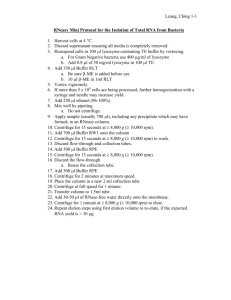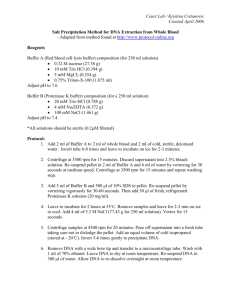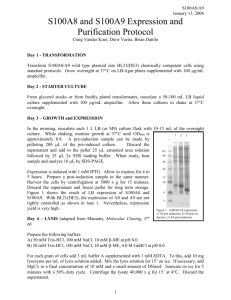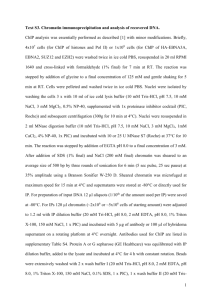ChIP using plant samples: Arabidopsis
advertisement
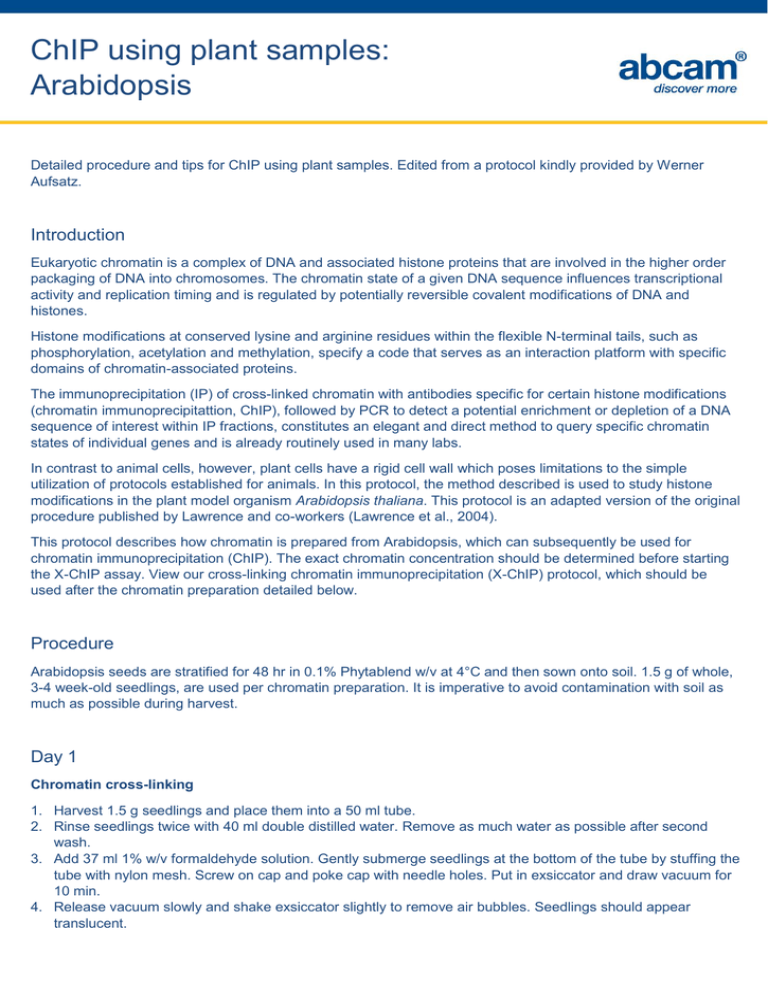
ChIP using plant samples: Arabidopsis Detailed procedure and tips for ChIP using plant samples. Edited from a protocol kindly provided by Werner Aufsatz. Introduction Eukaryotic chromatin is a complex of DNA and associated histone proteins that are involved in the higher order packaging of DNA into chromosomes. The chromatin state of a given DNA sequence influences transcriptional activity and replication timing and is regulated by potentially reversible covalent modifications of DNA and histones. Histone modifications at conserved lysine and arginine residues within the flexible N-terminal tails, such as phosphorylation, acetylation and methylation, specify a code that serves as an interaction platform with specific domains of chromatin-associated proteins. The immunoprecipitation (IP) of cross-linked chromatin with antibodies specific for certain histone modifications (chromatin immunoprecipitattion, ChIP), followed by PCR to detect a potential enrichment or depletion of a DNA sequence of interest within IP fractions, constitutes an elegant and direct method to query specific chromatin states of individual genes and is already routinely used in many labs. In contrast to animal cells, however, plant cells have a rigid cell wall which poses limitations to the simple utilization of protocols established for animals. In this protocol, the method described is used to study histone modifications in the plant model organism Arabidopsis thaliana. This protocol is an adapted version of the original procedure published by Lawrence and co-workers (Lawrence et al., 2004). This protocol describes how chromatin is prepared from Arabidopsis, which can subsequently be used for chromatin immunoprecipitation (ChIP). The exact chromatin concentration should be determined before starting the X-ChIP assay. View our cross-linking chromatin immunoprecipitation (X-ChIP) protocol, which should be used after the chromatin preparation detailed below. Procedure Arabidopsis seeds are stratified for 48 hr in 0.1% Phytablend w/v at 4°C and then sown onto soil. 1.5 g of whole, 3-4 week-old seedlings, are used per chromatin preparation. It is imperative to avoid contamination with soil as much as possible during harvest. Day 1 Chromatin cross-linking 1. Harvest 1.5 g seedlings and place them into a 50 ml tube. 2. Rinse seedlings twice with 40 ml double distilled water. Remove as much water as possible after second wash. 3. Add 37 ml 1% w/v formaldehyde solution. Gently submerge seedlings at the bottom of the tube by stuffing the tube with nylon mesh. Screw on cap and poke cap with needle holes. Put in exsiccator and draw vacuum for 10 min. 4. Release vacuum slowly and shake exsiccator slightly to remove air bubbles. Seedlings should appear translucent. 5. Add 2.5 ml 2 M glycine to quench cross-linking. Draw vacuum for 5 min. 6. Again, release vacuum slowly and shake exsiccator slightly to remove air bubbles. 7. Remove nylon mesh, decant supernatant and wash seedlings twice with 40 ml of double distilled water. After second wash, remove as much water as possible and put seedlings between two layers of kitchen paper. Roll up paper layers carefully to remove as much liquid as possible. At this step, plant material can be snap-frozen in liquid nitrogen and stored at -80°C. Chromatin preparation 1. Pre-cool mortar with liquid nitrogen. Add two small spoons of white quartz sand and plant material. Grind plant material to a fine powder. 2. Use cooled spoon to add powder to 30 ml of extraction buffer 1 stored on ice. Vortex to mix and keep at 4°C until solution is homogenous. 3. Rotate for 30 min at 4°C on a turning wheel or equivalent. 4. Filter extract through into a new, ice-cold 50 ml conical tube. Press to recover extract from solid material. 5. Repeat step 4. 6. Centrifuge extract at 4000 rpm for 20 min at 4°C. 7. Gently pour off supernatant and resuspend pellet in 1 ml of extraction buffer 2 by pipetting up and down. Transfer solution to Eppendorf tube. 8. Spin in cooled benchtop centrifuge at 13000 rpm for 10 min. 9. Remove supernatant and resuspend pellet in 300 µl of extraction buffer 2 by pipetting up and down. 10. Add 300 µl of extraction buffer 3 to fresh Eppendorf tube. Use pipette to carefully later solution from step 9 onto it. 11. Spin in cooled benchtop centrifuge at 13000 rpm for 10 min. In meantime, prepare 10 ml nuclei lysis buffer and 20 ml ChIP dilution buffer. Put buffers in cold room. 12. Remove supernatant and resuspend pellet in 300-500 µl of cold nuclei lysis buffer. Resuspend by pipetting up and down and by vortexing. Keep solution cold between vortexing. Incubate for 20 min on ice. 13. Remove 10 µl to run on an agarose gel. 14. Sonicate for 10 min at 4°C with sonicator: Setting “HIGH”, 10 sec “ON cycle”, 45 sec “OFF cycle”. Make sure that the solution does not foam during sonication, e.g., by cooling the tubes with a mix of 100% w/v ethanol in ice during the sonication step. 15. Spin in cooled benchtop centrifuge at 13000 rpm for 10 min. Add supernatant to new Eppendorf tube. 16. Repeat step 14. Remove 10 µl to run on an agarose gel. 17. Separate aliquots from steps 12 and 15 on 1.5% w/v agarose gel. In the sonicated samples, DNA should be shifted and more intense compared to untreated samples and range between 200-2000 bp, centering around 500 bp. Following step 16, the chromatin samples can be “snap-frozen” in liquid nitrogen and stored at -80°C. Repeated freezing/thawing cycles, however, should be avoided. Pre-clearing and immunoprecipitation (IP) 1. Transfer chromatin to 15 ml Falcon tubes. Dilute 1/10 with fresh, ice-cold ChIP dilution buffer. 2. Prepare protein A agarose beads pre-adsorbed with sheared salmon sperm DNA by rinsing the required amount of beads 3 times with 1 ml ChIP dilution buffer in an Eppendorf tube. Spin in cooled benchtop centrifuge for 30 sec at 13000 rpm between the washes to pellet the beads. After the last wash, resuspend the beads with ChIP dilution buffer to yield a 25% slurry (for pipetting reasons). 3. Pre-clear each chromatin sample by adding 140 µl of washed beads. Rotate for 1 hr at 4°C. 4. Spin Falcon tubes in a cooled centrifuge for 3 min at 3000 rpm to pellet the beads and transfer the supernatant to a new Falcon tube. Be careful not to carry over beads. 5. Store at 60 µl aliquot of pooled chromatin at -20°C. This will serve as input control later on. 6. Add 600 µl of chromatin solution per IP to an Eppendorf tube with an appropriate antibody. The optimal chromatin/antibody ratio has to be determined empirically for each antibody used. As a “rule of thumb”, use about 10 µg of antibody per IP for polyclonal antibodies. For monoclonal antibodies, usually a 1.5x to 4x higher concentration has to be used. Also set up 600 µl of chromatin solution with an unrelated antibody as a mock IP. 7. Add 80 µl of washed Protein A agarose beads to the chromatin IPs (25% slurry; for the preparation see step 2). Rotate overnight at 4°C. Day 2 Collection, washes and elution of immune complexes 1. Prepare fresh elution buffer and place it at 65°C. 2. Spin IPs in cooled benchtop centrifuge at 5000 rpm for 30 sec to collect beads and discard the supernatant. 3. Add 1 ml of low salt wash buffer per tube. Rotate for 5 min at 4°C. 4. Spin in cooled benchtop centrifuge at 5000 rpm for 30 sec to collect beads and discard supernatant. 5. Add 1 ml of high salt wash buffer per tube. Rotate for 5 min at 4°C. 6. Spin in cooled benchtop centrifuge at 5000 rpm for 30 sec to collect beads and discard supernatant. 7. Add 1 ml of LiCl wash buffer per tube. Rotate for 5 min at 4°C. 8. Spin in cooled benchtop centrifuge at 5000 rpm for 30 sec to collect beads and discard supernatant. 9. Add 1 ml of TE buffer per tube. Rotate for 5 min at 4°C. 10. Spin in cooled benchtop centrifuge at 5000 rpm for 30 sec to collect beads and discard supernatant. 11. Repeat TE wash. Spin in cooled benchtop centrifuge at 5000 rpm for 30 sec to collect beads and discard supernatant. 12. Elute immune complexes by adding 250 µl of elution buffer. Vortex briefly to mix and incubate at 65°C for 15 min. Spin in benchtop centrifuge at 13000 rpm for 30 sec and transfer supernatant to a fresh Eppendorf tube. 13. Repeat elution and finally combine the two elutes. Reverse cross-linking 1. Add 20 µl of 5M NaCl to samples. Incubate overnight at 65°C. 2. Add 109 µl of TE buffer, 7/1 µl of 5 M NaCl and 8.7 µl 20% SDS to the 60 µl input control aliquoted on Day 1. Incubate overnight at 65°C. Day 3 DNA cleanup 1. Add 10 µl of 0.5M EDTA, 20 µl 1M Tris-HCl pH 6.5 and 1 µl of 20 mg/ml proteinase K to the IP samples. Add 1.2 µl of 0.5M EDTA, 2.4 µl 1M Tris-HCl pH 6.5 and 1 µl of 20 mg/ml proteinase K to the input control samples. Incubate for 1-3 hr at 45°C. The samples can be gently shaken through this incubation. 2. Purify the DNAs using a silica-gel membrane (e.g. PCR purification kit). Elute DNAs twice with 50 µl 10 mM Tris-HCl pH 8.0 and pool elutes. Proceed to PCR reactions. An excellent guide to quantification of ChIP by real-time PCR is provided by Haring et al. (2007). Materials and reagents Extraction buffer 1 0.4 M Sucrose 10 mM Tris-HCl, pH 8.0 10 mM MgCl2 5 mM β-mercaptoethanol Protease inhibitors Extraction buffer 2 0.25 M Sucrose 10 mM Tris-HCl, pH 8.0 10 mM MgCl2 1% w/v Triton X-100 5 mM β-mercaptoethanol Protease inhibitors Extraction buffer 3 1.7 M Sucrose 10 mM Tris-HCl, pH 8.0 2 mM MgCl2 0.15% w/v Triton X-100 5 mM β-mercaptoethanol Protease inhibitors Nuclei lysis buffer 30 mM Tris-HCl, pH 8.0 10 mM EDTA 1% w/v SDS Protease inhibitors Protease inhibitor 1 mM PMSF (final concentration) Protease inhibitor cocktail (follow manufacturer’s instructions) ChIP dilution buffer 1.1% Triton X-100 1.2 mM EDTA 16.7 mM Tris-HCl, pH 8.0 167 mM NaCl Elution buffer 1% SDS 0.1 M NaHCO3 Low salt wash buffer 150 mM NaCl 0.1% SDS 1% Triton X-100 2 mM EDTA 20 mM Tris-HCl, pH 8.0 High salt wash buffer 500 mM NaCl 0.1% SDS 1% Triton X-100 2 mM EDTA 20 mM Tris-HCl, pH 8.0 LiCl wash buffer 0.25 M LiCl 1% Nonident P-40 1% sodium deoxycholate 1 mM EDTA 10 mM Tris-HCl, pH 8.0 TE buffer 10 mM Tris-HCl, pH 8.0 1 mM EDTA References: Haring M, Offerman S, Danker T, Horst I, Peterhansel C, Stam M (2007). Chromatin immunoprecipitation: optimization, quantitive analysis and data normalization. Plant methods, 3:11. Lawrence RJ, Earley K, Pontes O, Silva M, Chen ZJ, Neves N, Viegas W and Pikaard CS (2004). A concerted DNA methylation/histone methylation switch regulates rRNA gene dosage control and nucleolar dominance. Mol Cell, 13: 599-609. Lippman Z, Gendrel AV, Black M, Vaughn MW, Dedhia N, McCombie WR, Lavine K, Mittal V, May B, Kasschau KD, Carrington JC, Doerge RW, Colot V and Martienssen R (2004). Role of transposable elements in heterochromatin and epigenetic control. Nature, 430: 471-476. Xie Z, Johansen LK, Gustafson AM, Kasschau KD, Lellis AD, Zilberman D, Jacobsen SE and Carrington JC (2004). Genetic and functional diversification of small RNA pathways in plants. PLoS Biol., 2: 642-652.


